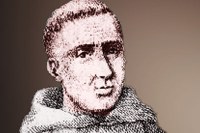While Irnerius founded his school of Roman Law on Justinian’s Corpus Iuris Civili, Gratian, the founder of the school of canon law, did not have the benefit of such a well-structured historical reference. He was indeed the one who created the foundation for the future Corpus Iuris Canonici, collecting in his Decretum and teaching his students one-thousand years of ecclesiastical legal texts that had never before been rigorously analysed.
 In all likelihood born in Chiusi, in Matilda’s Tuscany (according to later sources, he was born in Ficulle, in the Province of Terni), Gratian taught liberal arts as a Camaldolese monk (although perhaps even a bishop) in the episcopal complex of the city cathedral.
In all likelihood born in Chiusi, in Matilda’s Tuscany (according to later sources, he was born in Ficulle, in the Province of Terni), Gratian taught liberal arts as a Camaldolese monk (although perhaps even a bishop) in the episcopal complex of the city cathedral.
The diocese of Chiusi was shaken at the time by heated feuds tied to the Investiture Controversy, having been partly ceded by the emperor Henry V to Pope Paschal II (1111), and thus finding itself caught between the Tuscan marquisate and the Church State. Gratian probably understood, in part through this disorder, the importance of law and the need to resolve the precarious balance of power through a new legal system.
During the schism over the papal election in 1130, Gratian sided with the imperial pope, Innocent II, following him to France as his advisor (he was present at the Council of Rheims in 1131). While there, he met various distinguished thinkers, including Peter Abelard, a precursor of scholasticism, and deepened his knowledge of various theological assumptions developed north of the Alps.
This was also the period during which he began writing his Decretum (Concordia discordantium canonum): a collection of canons and decretals gathered and explained in an innovative way, using a modern and autonomous juridical scientific method.
Between 1132 and 1133, he began teaching in Bologna at the monasteries of S. Felice e Naborre, S. Procolo and S. Stefano, founding the school of canon law, which was the first to separate the legal from the theological.
He also forged ties with the local school of Glossators, learning about many concepts of Roman law that he then incorporated into the Decretum.
His numerous students included Rolando Bandinelli, the future pope Alexander III, with whom he went to Rome in 1139 to attend the Second Lateran Council, after which he revised the Decretum.
He probably died in 1145, entrusting his work to the school of Decretists, which was responsible for continuing to study and update the texts discussed in the treatise.
The Decretum remained fundamental to the teaching of the liberal arts in all of Europe and in the Bologna school of canon law, as well as a practical manual in ecclesiastical courts.
After numerous reassessments, it was officially promulgated by the Bolognese pope Gregory XIII (born Ugo Boncompagni) in 1580, two years before it became the cornerstone of the Corpus Iuris Canonici, the Catholic church’s main normative text in use until 1917.
Gratian’s authority was universally recognised and even commemorated in Canto X of Dante’s Paradiso, in which St Thomas Aquinas presents the jurist to Dante as a wise spirit in the bright Sphere of the Sun:
That next flame comes forth from the smile
of Gratian, who helped both forums
so much that Heaven is pleased.
